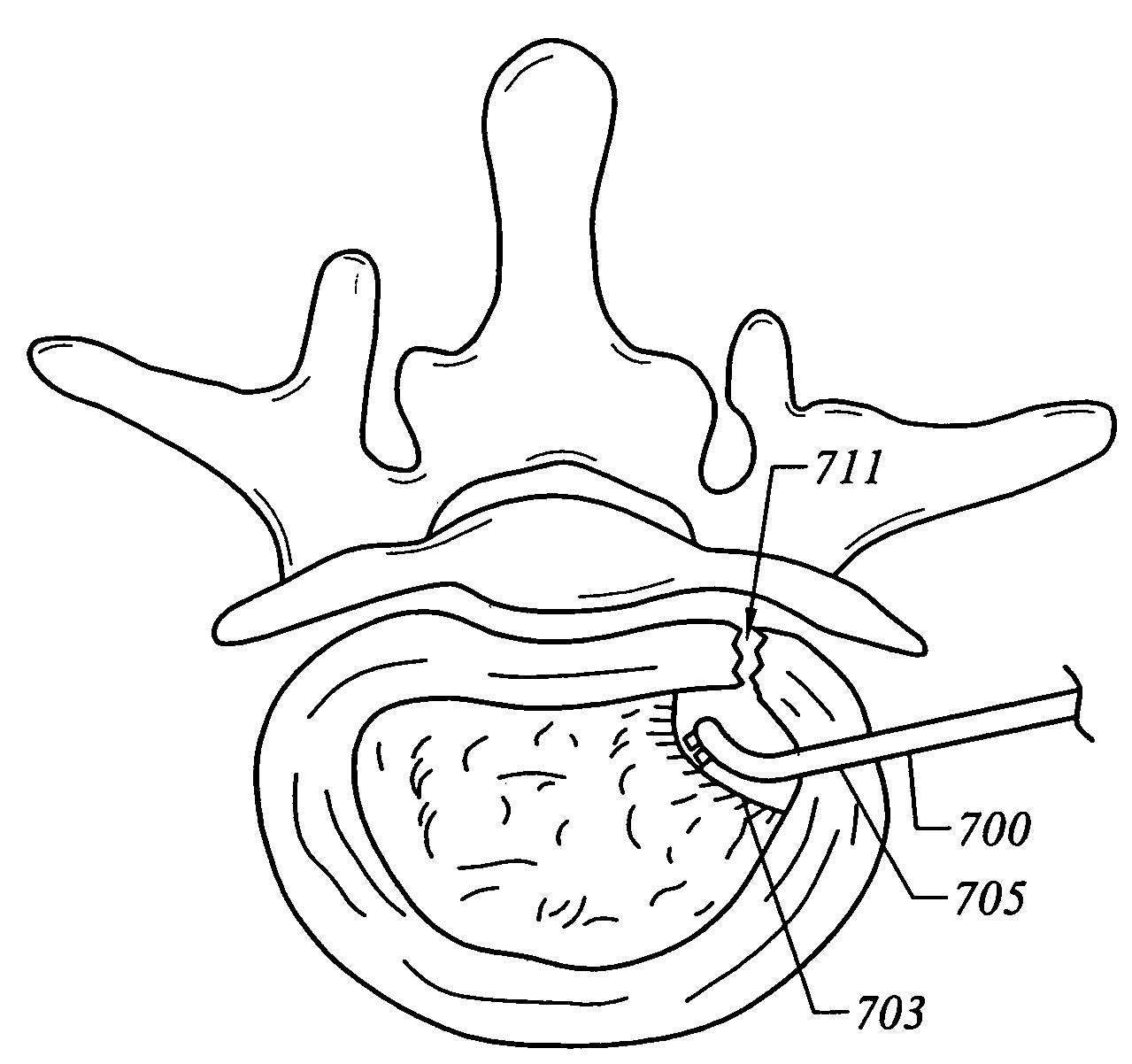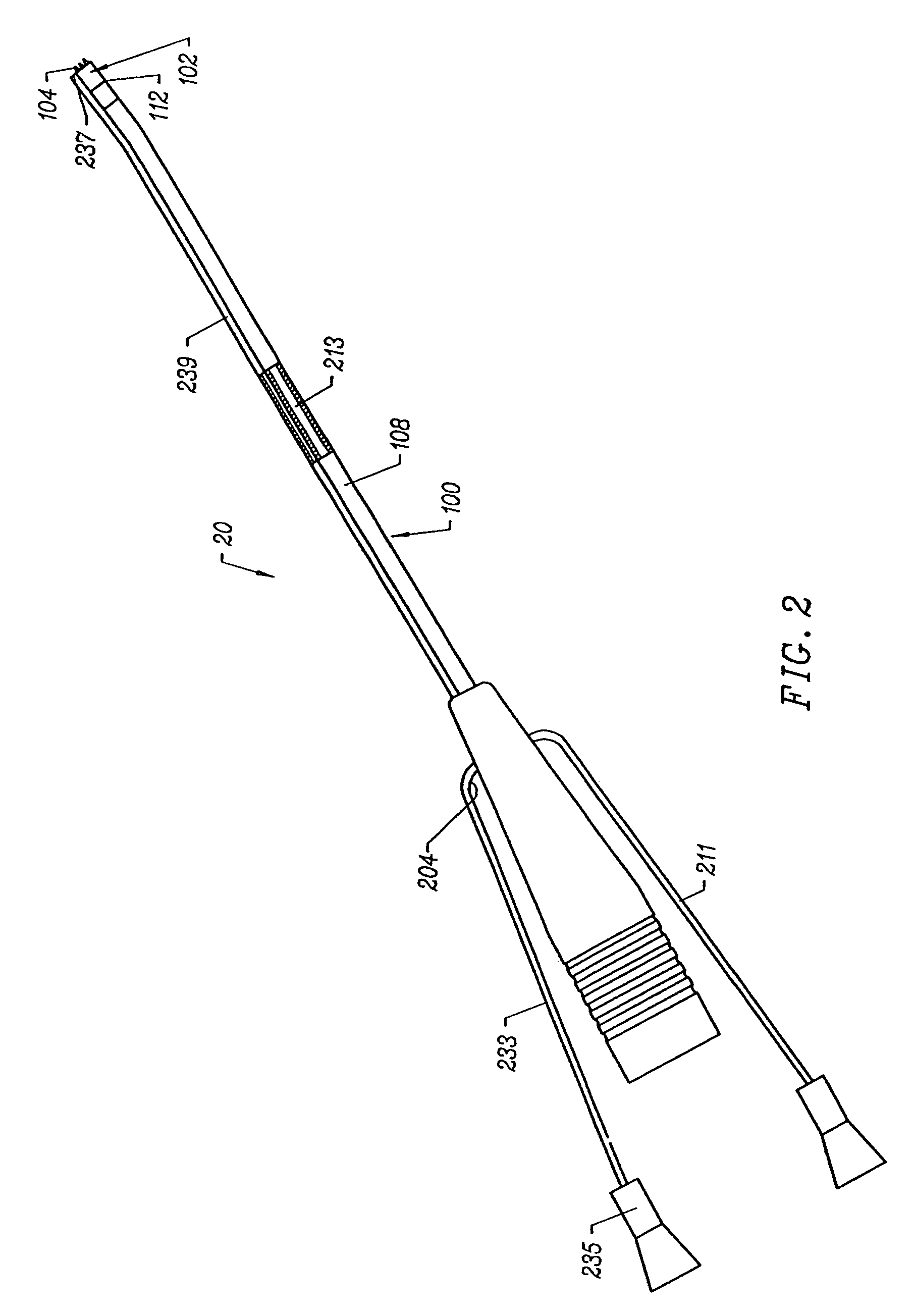[0031]In procedures requiring
ablation of tissue, the tissue is removed by molecular dissociation or disintegration processes. In these embodiments, the
high frequency voltage applied to the electrode terminal(s) is sufficient to vaporize an
electrically conductive fluid (e.g., gel or
saline) between the electrode terminal(s) and the tissue. Within the vaporized fluid, a ionized
plasma is formed and charged particles (e.g., electrons) are accelerated towards the tissue to cause the molecular breakdown or disintegration of several
cell layers of the tissue. This molecular dissociation is accompanied by the volumetric removal of the tissue. The short range of the accelerated charged particles within the
plasma layer confines the molecular dissociation process to the
surface layer to minimize damage and
necrosis to the underlying tissue. This process can be precisely controlled to effect the volumetric removal of tissue as thin as 10 to 150 microns with minimal heating of, or damage to, surrounding or underlying tissue structures. A more complete description of this phenomena is described in commonly assigned U.S. Pat. No. 5,683,366, the complete disclosure of which is incorporated herein by reference.
[0032]In another aspect of the invention, the present invention is useful for helping to create an operating corridor or passage between a
percutaneous penetration in the patient's outer
skin and a target area within the spine. Typically, this operating corridor is initially created by inserting one or more dilators through the
percutaneous penetration to the target area within the spine, and then introducing a tubular
retractor or similar instrument over the largest
dilator. Once this is accomplished, the hollow interior of the
retractor (which will serve as the operating corridor for the introduction of the necessary instruments, such as the
endoscope) is typically partially filled with
soft tissue,
muscle and other body structures. The present invention is particularly useful for precisely and quickly removing these body structures to clear the operating corridor. To that end, an electrosurgical probe according to the invention is delivered into the hollow
retractor, and one or more electrode terminal(s) are positioned adjacent to or in contact with the
soft tissue or other body structures to be removed.
High frequency voltage is applied between the electrode terminal(s) and one or more return electrodes such that the tissue is removed.
[0033]The tissue may be completely ablated in situ with the mechanisms described above, or the tissue may be partially ablated and partially resected and aspirated from this operating corridor. In the latter embodiment, the method of the present invention further comprises aspirating tissue fragments and fluid through an aspiration lumen in the electrosurgical instrument or another instrument. In a preferred configuration, the probe will include one or more aspiration electrode(s) at or near the distal opening of the aspiration lumen. In this embodiment, high frequency voltage is applied between the aspiration electrode(s) and one or more return electrode(s) (which can be the same or different electrodes from the ones used to ablate tissue) to partially or completely ablate the tissue fragments as they are aspirated into the lumen, thus inhibiting clogging of the lumen and expediting the tissue removal process.
[0034]The present invention offers a number of advantages over current mechanical and
laser techniques for
spine surgery. The ability to precisely control the volumetric removal of tissue results in a field of
tissue ablation or removal that is very defined, consistent and predictable. The shallow depth of
tissue heating also helps to minimize or completely eliminate damage to
healthy tissue structures,
cartilage, bone and / or spinal nerves that are often adjacent the
target tissue. In addition, small blood vessels within the tissue are simultaneously cauterized and sealed as the tissue is removed to continuously maintain
hemostasis during the procedure. This increases the surgeon's
field of view, and shortens the length of the procedure. Moreover, since the present invention allows for the use of
electrically conductive fluid (contrary to prior art bipolar and
monopolar electrosurgery techniques), isotonic
saline may be used during the procedure.
Saline is the preferred medium for
irrigation because it has the same concentration as the body's fluids and, therefore, is not absorbed into the body as much as other fluids. Alternatively, saline-rich tissue can be used as the conductive medium.
[0035]Apparatus according to the present invention generally include an electrosurgical probe or
catheter having a shaft with proximal and distal ends, one or more electrode terminal(s) at the distal end and one or more connectors
coupling the electrode terminal(s) to a source of high frequency electrical energy. The shaft will have a distal end portion sized to fit between adjacent vertebrae in the patient's spine. In some embodiments, the distal end portion is substantially planar, and it offers a low profile, to allow access to confined spaces without risking
iatrogenic injury to surrounding body structures or nerves, such as vertebrae or spinal nerves. Usually, the distal end portion will have a combined height (i.e., including the
active electrode(s)) of less than 2 mm and preferably less than 1 mm.
[0036]The apparatus will preferably further include a fluid delivery element for delivering electrically conducting fluid to the electrode terminal(s) and the
target site. The fluid delivery element may be located on the probe, e.g., a fluid lumen or tube, or it may be part of a separate instrument. Alternatively, an electrically conducting gel or spray, such as a saline
electrolyte or other conductive gel, may be applied the
target site, or saline-rich tissue may be used, such as the nucleus. In this embodiment, the apparatus may not have a fluid delivery element. In both embodiments, the electrically conducting fluid will preferably generate a current flow path between the electrode terminal(s) and one or more return electrode(s). In an exemplary embodiment, the return electrode is located on the probe and spaced a sufficient distance from the electrode terminal(s) to substantially avoid or minimize current shorting therebetween and to shield the return electrode from tissue at the
target site.
 Login to View More
Login to View More 


